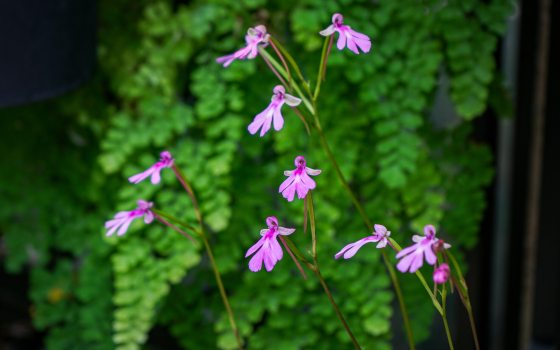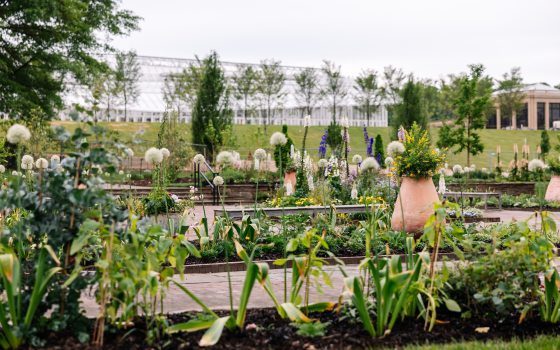What if there was a genus of orchid that was easy to grow, vigorous, nearly unkillable, only required active care for half the year, had attractive foliage, was incredibly floriferous, had beautiful flowers, and could (for the most part) easily fit on your windowsill? What if that genus was virtually unknown in cultivation, but was sitting right under our noses the entire time? That is precisely what we’ve discovered about the genus Cynorkis! This genus, while in cultivation for at least 100 years, has been nearly unknown, ungrown, and has been hybridized very little—but we now are actively hybridizing them here at Longwood. It’s also potentially one of the greatest windowsill orchids you can grow at home—and our first hybrid Cynorkis—Cynorkis Longwood Pink Gem—is now on view for the first time in our Orchid House for the next week, and ready to delight.
The genus Cynorkis comes from Africa, with the greatest concentration of species in Madagascar and the southeast nations. It has about 190 species, although only perhaps a dozen are known in cultivation in the United States. Here at Longwood, we have six Cynorkis species in our collection, which—while not currently on view—have begun to form the building blocks of the Cynorkis hybrids in our collection.
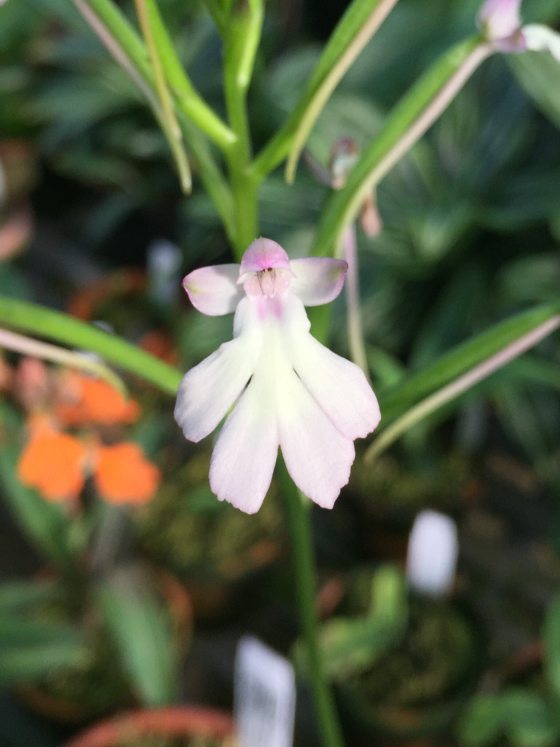
Among the most common of those species in cultivation is Cynorkis fastigiata, a miniature, self-pollinating species that grows at an incredibly fast rate, and of which you will have a few dozen seedlings appearing in every other pot around if the seedpods are left to open in a greenhouse or near other plants. Photo by Greg Griffis.
After that we have the giant: Cynorkis calanthoides. Often historically confused with Cyn. purpurascens, which is far less common, it is a plant that can grow leaves almost two feet long, with huge umbels of dozens of lovely lavender to purple colored flowers.
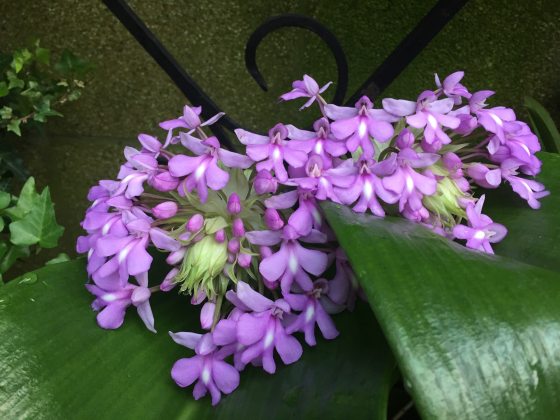
Cynorkis calanthoides ‘Peter’. Photo by Greg Griffis.
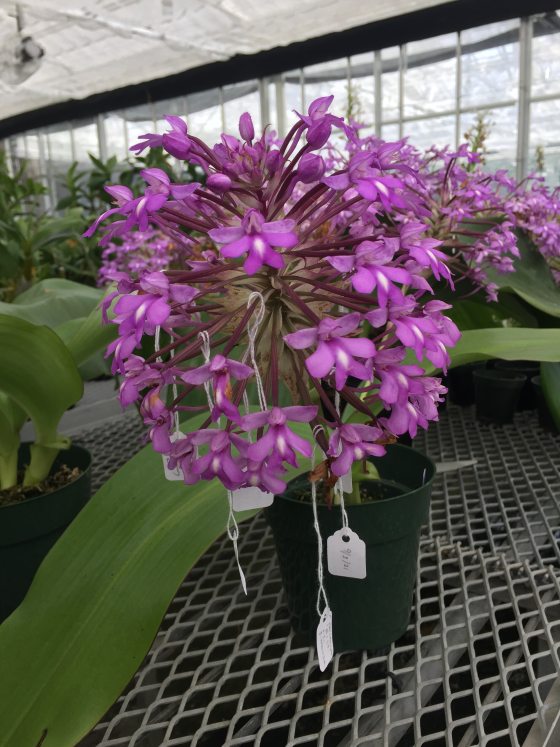
Cynorkis calanthoides ‘Longwood’s Best’ with pollination tags, a parent of many of our new hybrids. Photo by Greg Griffis.
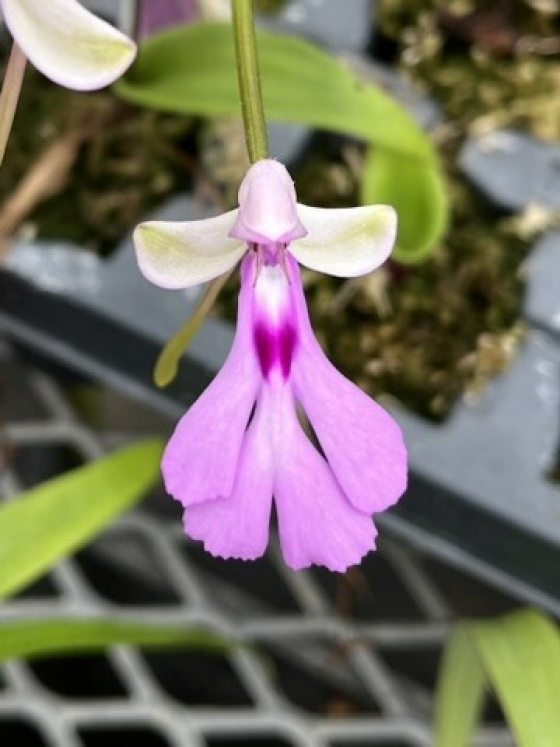
An attractive winter flowering species is Cynorkis lowiana, which is a small plant with large flowers, and with a purple lip with a dark purple splotch in the center of the lip. Photo by Greg Griffis.
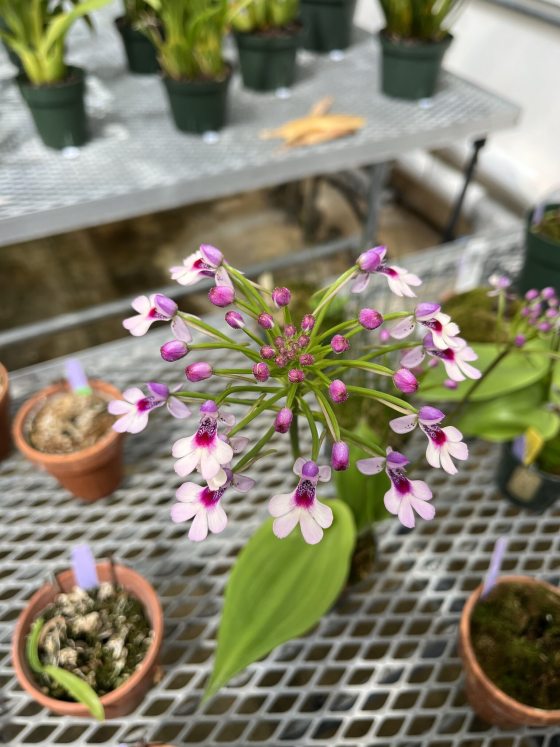
Cynorkis angustipetala is fairly common, and has tall umbels of numerous white to pale pink flowers, marked with a maroon splotch with typically purple or pink sepals. Photo by Greg Griffis.
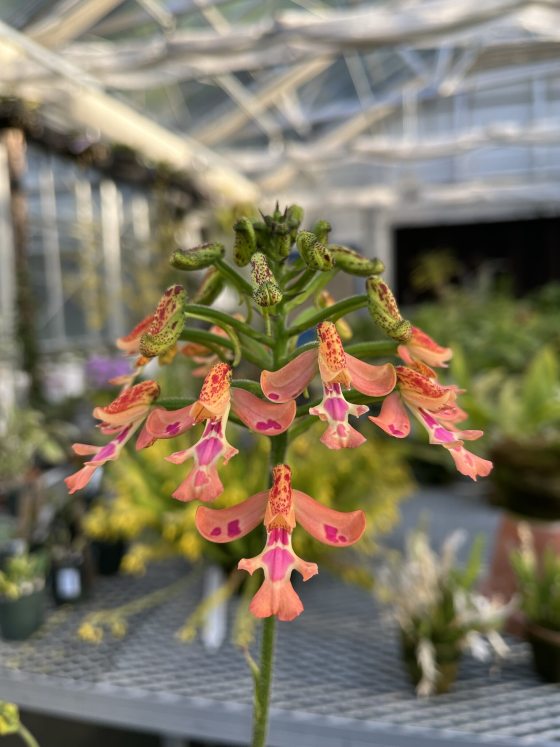
Perhaps one of the showiest species in cultivation, Cynorkis gibbosa has a striking orange flower with purple markings, and leaves that also have purple spots. Photo by Greg Griffis.
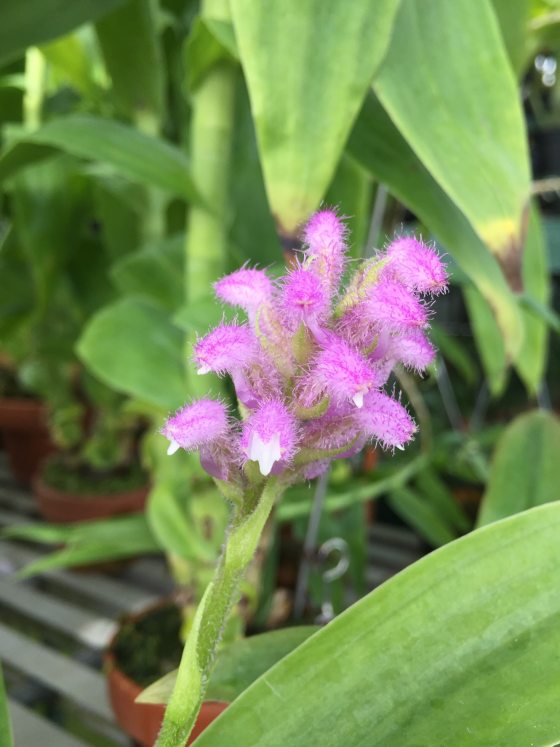
The last species we have here at Longwood is a little less common, but is quite interesting. Cynorkis villosa is named for its hairy flowers that are small and cupped, but it is a fascinating and beautiful sight to behold. Photo by Greg Griffis.
The history of Cynorkis hybridization is a short one. In 1903 Royal Botanic Gardens, Kew in the UK registered the first two hybrids, and then 115 years passed before the next hybrid was registered. In 2018, Dr. Harold Koopowitz registered a hybrid, and the following year, Louisiana Orchid Connection registered another.
We had been growing Cynorkis at Longwood for a few years by the time the fourth Cynorkis hybrid was registered in 2019, and we soon jumped in on hybridizing Cynorkis: Our first hybrid, Cynorkis Longwood Pink Gem, was registered in 2022.
Cynorkis Longwood Pink Gem is a hybrid between Cynorkis lowiana × Cynorkis fastigiata, and is remarkable for a number of reasons. The most amazing aspect of this hybrid is that it grew from seed to flowering in one year, two months, and six days! This is incredibly fast for an orchid. Most orchids take between five to seven years from seed to first flower, and even the fastest groups usually take about three years. On top of that, many of the flowers were beautifully shaped, full-figured, and flat. At first, many of the flowers that opened were lavender in color, with a white splotch in the center of the lip, and greenish sepals. However, as time went on, even better flowers opened up, revealing neon-pink lips and sepals, and even better form and shape. These plants are currently flowering with about five to seven flowers on two-year-old seedlings. However, this number may increase in time as the plants become even more mature.
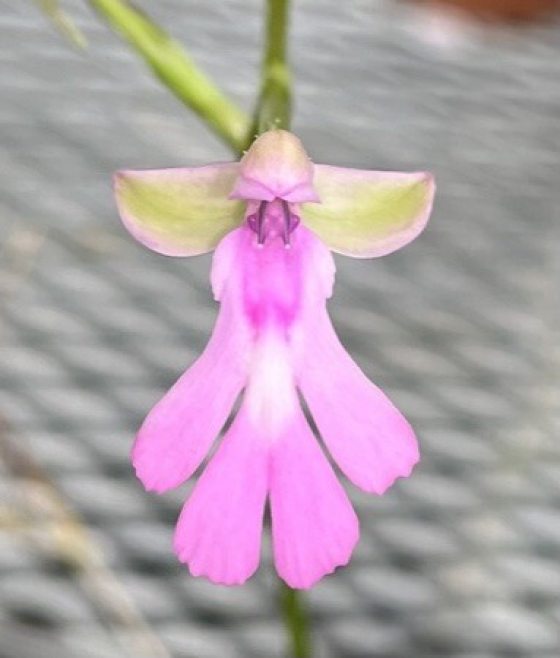
A good example of a typical lavender colored outcome of Cynorkis Longwood Pink Gem. Photo by Greg Griffis.
The best part about all Cynorkis, but especially this hybrid, is that they are easy to grow! Cynorkis like intermediate light of about 1500 – 2500 footcandles, which is typically the light coming indirectly through an east window or through a shaded south window—making them great windowsill plants. They are small, maturing in a 2-inch pot, and potentially forming a specimen size plant in a 4- or 5-inch pot. They like a temperature range of about 55 degrees F to 85 degrees F, which means that our homes are already the perfect temperatures for them.
The scariest part of growing Cynorkis is that they have a dormancy period—but this is where Cynorkis shine brightest. Unlike many of their relatives, which need a dry winter dormancy, Cynorkis like to stay barely evenly moist through the winter, which means much less guesswork (and fear!). If you are growing them in sphagnum moss, as we do, you only need water when you touch the moss on the top of the pot and can’t quite tell if it is wet or dry. That is the perfect time to water during their winter dormancy. If you happen to water a bit too much one week, or forget them for a week or two, no worries! They are resilient and forgiving. During their active growth period, keep them evenly moist.
So, what comes next? We certainly aren’t done our work in this genus, and in fact have already registered another hybrid (Cynorkis Longwood Villous Gem); remade one of the earliest hybrids (Cynorkis Kewensis grex); are line breeding the best species (we have seedlings of a Cynorkis calanthoides outcross and Cynorkis lowiana outcross growing up now), and have another 14 new crosses in the lab as we speak.
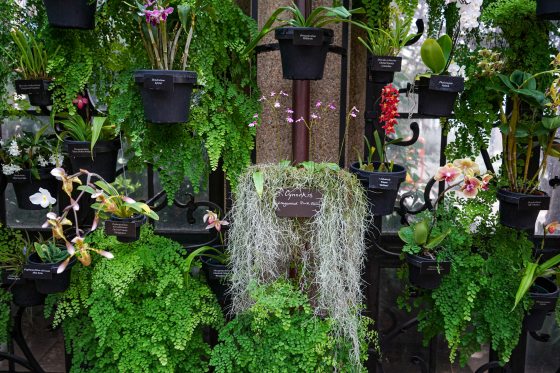
Cynorkis Longwood Pink Gem, on view now in our Orchid House. Photo by Carol Gross.
With hybridizing Cynorkis, our goal is to create compact hybrids with short (12- to 18-inch) inflorescences that carry between one- to two-dozen flowers; are well arranged in an umbel; have full, round, flat shape; and bright, eye-catching colors. These plants would be mature and approaching specimen size in a 5- or 6-inch pot, and will grow easily and reliably, flowering at least once a year, with flowers lasting at least one month, if not more. Because different Cynorkis species flower at different times of year, it is the hope that we can produce different hybrids for different seasons, so that, within reason, if you had one dozen Cynorkis hybrids, you would always have at least one plant in flower throughout the year.
The potential for this group is only barely being uncovered now—we should flower another two or three hybrids this year, and in the future, who knows what is possible! These are truly lovely and fascinating little gems, and all the more precious because they are so easy to grow.
Editor’s note: Come see a group of our Cynorkis Longwood Pink Gem here in the Orchid House, on display until mid-May and identified by an “as seen on social” sign.
